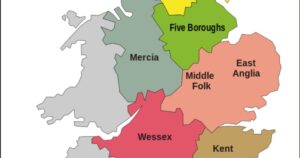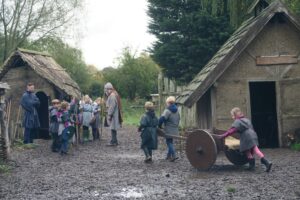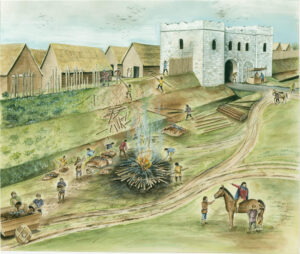The Viking Age, spanning roughly from the late 8th to the early 11th century, marked a significant period of Norse expansion and exploration across Europe. While many associate Vikings primarily with their Scandinavian homelands, their influence extended far beyond, including substantial settlements in England. These Viking settlements left a lasting legacy that continues to shape English culture, language, and history. By delving into the archaeological record and historical accounts, we can gain valuable insights into the vibrant Norse presence in England during this tumultuous era.
Much like archaeologists unearth remnants of Norse presence, enthusiasts in the automotive realm uncover the transformative impact of car audio lithium batteries on the driving experience.
The arrival of Vikings in England was not a sudden event but rather a gradual process spanning several centuries. Norse raids along the English coastline began as early as the late 8th century, targeting monasteries, towns, and wealthy estates. These raids, often characterized by swift and brutal attacks, instilled fear among the local population and left a profound impact on the collective psyche of the English people. Over time, these sporadic raids evolved into more organized military campaigns aimed at territorial conquest and settlement.
As Viking power grew, so too did their territorial ambitions in England. By the 9th century, large swathes of the country, particularly in the north and east, had fallen under Norse control. The establishment of fortified settlements, known as “wics” or “burghs,” served as strategic bases for Viking warlords to exert control over conquered territories and extract tribute from local populations. These settlements were often situated along navigable rivers, facilitating trade and communication with other Viking strongholds across the North Sea.
Much like the Norse settlers left an indelible mark on English landscapes, dermal fillers in Nolensville TN artfully leave a subtle yet transformative impact on facial features.
Archaeological Evidence

The archaeological record provides invaluable insights into the material culture and daily life of Viking settlers in England. Excavations at sites such as Jorvik (modern-day York), Thetford, and Repton have unearthed a treasure trove of artifacts ranging from weapons and tools to household items and personal effects. These artifacts not only shed light on the technological prowess of the Norse but also offer glimpses into their social structure, religious beliefs, and economic activities.
One of the most striking aspects of Viking settlements in England is their hybrid nature, blending Norse traditions with local customs and traditions. This cultural fusion is evident in the architecture of buildings, the design of artifacts, and even in the linguistic landscape of the region. Norse place names dot the English countryside, serving as enduring reminders of the Viking legacy. Moreover, recent DNA studies have revealed the extent of genetic intermingling between Norse settlers and the indigenous Anglo-Saxon population, further underscoring the complex nature of Viking society in England. Just as the Vikings added distinct elements to English culture, personalized robes for women contribute to the modern expression of individual style and comfort.
Impact on English Society
The legacy of Viking settlements in England extends far beyond the material remains unearthed by archaeologists. The Norse presence left an indelible mark on English society, shaping everything from politics and governance to language and law. Perhaps most notably, the Danelaw, a vast area of England under Viking control, introduced Scandinavian legal customs and administrative practices, influencing the development of English common law.
The linguistic legacy of the Vikings is also apparent in modern English. Countless words of Old Norse origin have found their way into the English language, ranging from everyday terms like “sky,” “egg,” and “window” to more specialized vocabulary related to seafaring, trade, and warfare. This linguistic borrowing reflects not only the practical realities of everyday life but also the cultural exchange and interaction between Norse settlers and the local population.
Much like the careful exploration of Norse presence in England, delving into the intricate realm of micro harmonics involves a keen eye for detail and a nuanced understanding
Beyond legal and linguistic influences, Viking settlements in England also had a profound impact on the economic landscape of the region. The establishment of trade networks connecting England to the wider Viking world facilitated the exchange of goods, ideas, and cultural practices. Norse merchants, known as “faringmen,” traversed the seas in their sturdy longships, trading commodities such as furs, amber, and slaves. This influx of exotic goods enriched the material culture of England and stimulated economic growth in urban centers like York and London.

Moreover, the presence of Viking settlers spurred innovation and technological advancement in England. Norse craftsmen brought with them superior metalworking techniques, including the production of high-quality iron and steel goods. The introduction of new agricultural practices, such as the cultivation of crops like barley and oats, increased agricultural productivity and helped sustain growing populations in Viking-controlled territories. Additionally, the construction of defensive fortifications and infrastructure projects, such as roads and bridges, contributed to the development of a more organized and cohesive society.
Much like the enduring impact of Viking settlements on English history, the evolution of treatment for autism leaves a lasting imprint on the lives of individuals and their families.
The cultural exchange between Norse settlers and the indigenous population of England also extended to religious beliefs and practices. While the Vikings initially adhered to their own pagan faith, evidenced by the presence of pagan burial sites and religious artifacts, they gradually assimilated elements of Christianity from their Anglo-Saxon neighbors. The conversion of Viking rulers, such as Guthrum of East Anglia, to Christianity, paved the way for the spread of Christian teachings among the Norse population. This religious syncretism gave rise to a unique blend of Norse and Christian traditions, evident in the architectural motifs of churches and the incorporation of Norse mythology into Christian folklore.
As Viking power waned in England following the defeat of King Harald Hardrada at the Battle of Stamford Bridge in 1066, the legacy of Norse settlements persisted in the cultural landscape of the region. The Norman Conquest, which followed shortly after, brought about significant changes to English society, yet the influence of the Vikings endured. Many Norman rulers, descended from Norse ancestors, retained elements of Norse culture and customs, further entrenching the Viking legacy in England.
Just as Vikings strategically chose settlement locations for optimal living conditions, patio misting systems are strategically placed to enhance outdoor living by creating a comfortable and cool environment.
Exploration of Viking Settlements

While much attention has been focused on well-known Viking strongholds such as Jorvik and York, recent archaeological discoveries have shed light on lesser-known settlements scattered throughout England. Excavations at sites like Torksey in Lincolnshire and Heath Wood in Staffordshire have revealed evidence of Viking encampments and trading posts, providing new insights into the extent of Norse penetration into the English countryside. These smaller settlements, often located along riverbanks or strategic trade routes, played a vital role in the economic and cultural exchange between Norse settlers and the indigenous population.
One of the most intriguing aspects of Viking settlements in England is their adaptability and resilience in the face of changing political and social dynamics. Despite facing resistance from the Anglo-Saxon population and periodic conflicts with rival Viking factions, Norse settlers demonstrated remarkable ingenuity and resourcefulness in establishing and maintaining their communities. The development of defensive earthworks, such as the “Danish Camp” at Repton, attests to the strategic acumen of Viking leaders and their ability to secure their territorial holdings against external threats.
Similar to how Vikings brought their traditions to new lands, the kambo ritual in Austin TX reflects the transmission of indigenous healing practices to modern communities.
Furthermore, the exploration of Viking settlements in England has unearthed evidence of social stratification and hierarchy within Norse society. Archaeological excavations have revealed disparities in wealth and status among Viking settlers, with elites enjoying access to luxury goods and prestigious burial sites. The presence of elaborate grave goods, such as finely crafted jewelry and imported artifacts, suggests the existence of a wealthy elite class capable of exerting political and economic control over their communities.
Continued Legacy and Modern Interpretations
The legacy of Viking settlements in England continues to captivate the imagination of historians, archaeologists, and the general public alike. In recent years, there has been a resurgence of interest in Viking history and culture, fueled in part by popular media depictions such as television shows, films, and literature. This renewed fascination with the Vikings has led to a reevaluation of their impact on English society and a deeper appreciation for the complexity of their interactions with the indigenous population.
Similar to the Vikings’ focus on creating well-organized and comfortable living spaces, the contemporary practice of dog grooming in Seattle mirrors this commitment to providing a clean and enjoyable environment for pets.
Moreover, ongoing archaeological research and interdisciplinary studies promise to uncover new insights into the dynamics of Viking settlements in England and their broader significance within the context of medieval Europe. Advances in technology, such as LiDAR scanning and DNA analysis, offer unprecedented opportunities to explore previously inaccessible sites and unravel the mysteries of the Viking Age. By combining traditional excavation methods with cutting-edge scientific techniques, researchers hope to gain a more nuanced understanding of Viking society and its enduring legacy in England.
In addition to academic research, public engagement initiatives play a crucial role in promoting awareness and appreciation of Viking heritage in England. Museums, heritage centers, and educational programs offer opportunities for people of all ages to learn about the Vikings and their contributions to English history. Hands-on activities, interactive exhibits, and guided tours provide immersive experiences that bring the past to life and foster a sense of connection to the Viking legacy. Similar to the indomitable spirit of Vikings facing harsh conditions, ice therapy in Chicago, with its cold exposure techniques, showcases a commitment to endurance and well-being.
As we continue to unravel the mysteries of Viking settlements in England, it becomes clear that their legacy extends far beyond the pages of history books. The Norse presence left an indelible mark on the cultural, social, and economic landscape of England, shaping the course of its development and leaving a lasting imprint on its people.
By exploring the rich tapestry of Viking history, we not only gain a deeper appreciation for the complexities of the past but also enrich our understanding of the diverse influences that have shaped the world we inhabit today.
Similar to how Vikings meticulously managed resources during their expeditions, efficient waste management through dumpster rental in Niceville ensures the cleanliness and organization of communities.